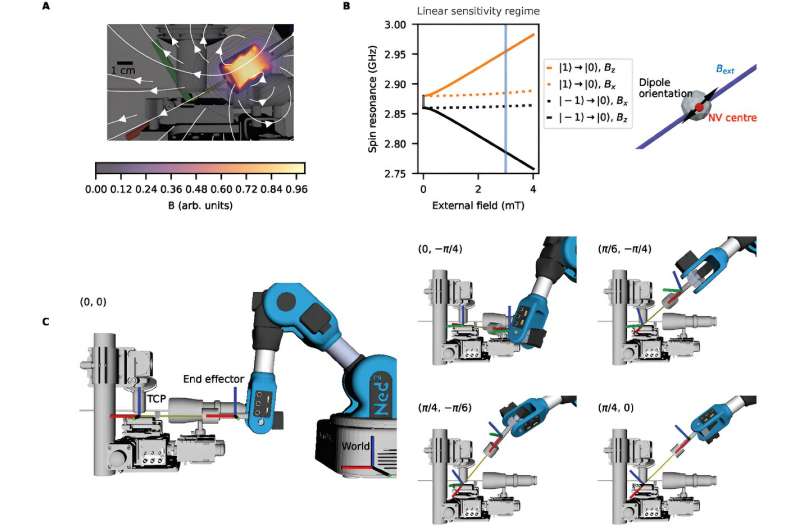This article has been reviewed according to Science X's editorial process and policies. Editors have highlighted the following attributes while ensuring the content's credibility:
fact-checked
peer-reviewed publication
trusted source
proofread
Pioneering robot arm poised to reach new heights in quantum

Scientists carrying out quantum research will be able to do so faster and more adaptably, thanks to a new robotic arm which could hold the key to major breakthroughs.
The invention, developed by researchers in Quantum Engineering Technology Labs and the Bristol Robotics Laboratory (BRL) at the University of Bristol, has a unique design, allowing quantum experiments to be conducted with unprecedented levels of speed, detail and complexity.
Quantum technology has a host of potential real-world applications, from health advances in monitoring the condition of cells to communication in space.
Experiments in quantum often require highly constrained environments, sometimes combining ultra-low temperatures, atomic-scale interactions, and tightly-aligned laser beams.
By building robotic features into quantum experiments, scientists will now be able to investigate these experiments with increased prototyping speed, control, and robustness.
The research findings and robotic arm were presented in the journal Advanced Science.
Lead author Dr. Joe Smith, Senior Research Associate in the School of Electrical, Electronic and Mechanical Engineering at the University of Bristol said, "We couldn't have performed this experiment using standard lab components, so we decided to look into robotics. We've shown that robotic arms are mature enough to navigate very complex settings."
"We're very keen for this technology to improve all sorts of quantum sensing experiments, and hopefully leading to these experiments leaving the quantum optics lab and find further useful applications, like in cell diagnostics."
Dr. Smith and his team were inspired by the way robots are being increasingly used in surgery as they are able to navigate complicated areas of the body with high precision.
Co-author Dr. Krishna Coimbatore Balram, Associate Professor in Photonic Quantum Engineering at the University of Bristol, said "This work demonstrates the importance of bringing developments from other fields, in this case robotics, to advance quantum technologies."
The high strength magnet the robot holds can be positioned anywhere in three-dimensional space at any angle, navigating around obstacles. Using tools such as electrodes, lasers, and mirror surfaces, robotic arms could facilitate more precise alignment and manipulation for various experimental set-ups.
More information: Joe A. Smith et al, Robotic Vectorial Field Alignment for Spin‐Based Quantum Sensors, Advanced Science (2023). DOI: 10.1002/advs.202304449
Journal information: Advanced Science
Provided by University of Bristol





















